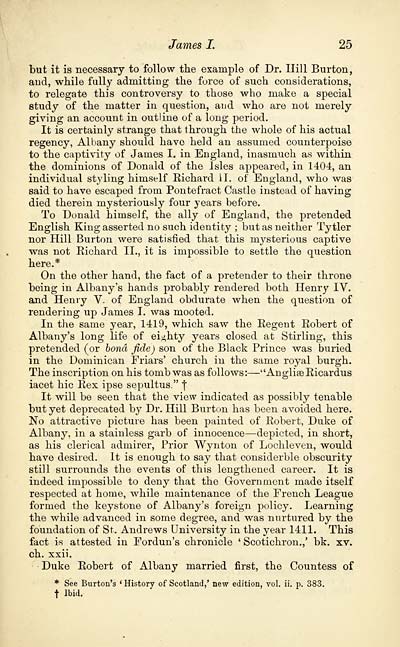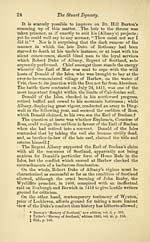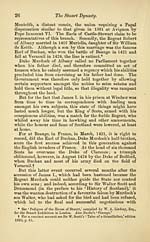Stuart dynasty
(45) Page 25
Download files
Complete book:
Individual page:
Thumbnail gallery: Grid view | List view

James I. 25
but it is necessary to follow the example of Dr. Hill Burton,
and, while fully admitting the force of such considerations,
to relegate this controversy to those who make a special
study of the matter in question, and who are not merely
giving an account in outline of a long period.
It is certainly strange that through the whole of his actual
regency, Albany should have held an assumed counterpoise
to the captivity of James I. in England, inasmuch as within
the dominions of Donald of the Isles appeared, in 1404, an
individual styling himself Eichard II. of England, who was
said to have escaped from Pontefract Castle instead of having
died therein mysteriously four years before.
To Donald himself, the ally of England, the pretended
English King asserted no such identity ; but as neither Tytler
nor Hill Burton were satisfied that this mysterious captive
was not Kichard II., it is impossible to settle the question
here.*
On the other hand, the fact of a pretender to their throne
being in Albany's hands probably rendered both Henry IV.
and Henry V. of England obdurate when the question of
rendering up James I. was mooted.
In the same year, 1419, which saw the Eegent Eobert of
Albany's long life of eighty years closed at Stirling, this
pretended (or bond fide) son of the Black Prince was buried
in the Dominican Friars' church in the same royal burgh.
The inscription on his tomb was as follows: — "AngliaBEicardus
iacet hie Eex ipse sepultus." j"
It will be seen that the view indicated as possibly tenable
but yet deprecated by Dr. Hill Burton has been avoided here.
No attractive picture has been painted of Eobert, Duke of
Albany, in a stainless garb of innocence — depicted, in short,
as his clerical admirer, Prior Wynton of Lochleven, would
have desired. It is enough to say that considerble obscurity
still surrounds the events of this lengthened career. It is
indeed impossible to deny that the Government made itself
respected at home, while maintenance of the French League
formed the keystone of Albany's foreign policy. Learning
the while advanced in some degree, and was nurtured by the
foundation of St. Andrews University in the year 1411. This
fact is attested in Fordun's chronicle ' Scotichron.,' bk. xv.
ch. xxii.
Duke Eobert of Albany married first, the Countess of
* See Burton's ' History of Scotland,' new edition, vol. ii. p. 383.
t Ibid.
but it is necessary to follow the example of Dr. Hill Burton,
and, while fully admitting the force of such considerations,
to relegate this controversy to those who make a special
study of the matter in question, and who are not merely
giving an account in outline of a long period.
It is certainly strange that through the whole of his actual
regency, Albany should have held an assumed counterpoise
to the captivity of James I. in England, inasmuch as within
the dominions of Donald of the Isles appeared, in 1404, an
individual styling himself Eichard II. of England, who was
said to have escaped from Pontefract Castle instead of having
died therein mysteriously four years before.
To Donald himself, the ally of England, the pretended
English King asserted no such identity ; but as neither Tytler
nor Hill Burton were satisfied that this mysterious captive
was not Kichard II., it is impossible to settle the question
here.*
On the other hand, the fact of a pretender to their throne
being in Albany's hands probably rendered both Henry IV.
and Henry V. of England obdurate when the question of
rendering up James I. was mooted.
In the same year, 1419, which saw the Eegent Eobert of
Albany's long life of eighty years closed at Stirling, this
pretended (or bond fide) son of the Black Prince was buried
in the Dominican Friars' church in the same royal burgh.
The inscription on his tomb was as follows: — "AngliaBEicardus
iacet hie Eex ipse sepultus." j"
It will be seen that the view indicated as possibly tenable
but yet deprecated by Dr. Hill Burton has been avoided here.
No attractive picture has been painted of Eobert, Duke of
Albany, in a stainless garb of innocence — depicted, in short,
as his clerical admirer, Prior Wynton of Lochleven, would
have desired. It is enough to say that considerble obscurity
still surrounds the events of this lengthened career. It is
indeed impossible to deny that the Government made itself
respected at home, while maintenance of the French League
formed the keystone of Albany's foreign policy. Learning
the while advanced in some degree, and was nurtured by the
foundation of St. Andrews University in the year 1411. This
fact is attested in Fordun's chronicle ' Scotichron.,' bk. xv.
ch. xxii.
Duke Eobert of Albany married first, the Countess of
* See Burton's ' History of Scotland,' new edition, vol. ii. p. 383.
t Ibid.
Set display mode to:
![]() Universal Viewer |
Universal Viewer | ![]() Mirador |
Large image | Transcription
Mirador |
Large image | Transcription
Images and transcriptions on this page, including medium image downloads, may be used under the Creative Commons Attribution 4.0 International Licence unless otherwise stated. ![]()
| Histories of Scottish families > Stuart dynasty > (45) Page 25 |
|---|
| Permanent URL | https://digital.nls.uk/94818306 |
|---|
| Description | A selection of almost 400 printed items relating to the history of Scottish families, mostly dating from the 19th and early 20th centuries. Includes memoirs, genealogies and clan histories, with a few produced by emigrant families. The earliest family history goes back to AD 916. |
|---|

